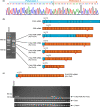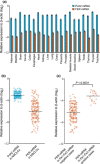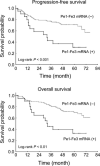Detection of novel paraja ring finger 2-fer tyrosine kinase mRNA chimeras is associated with poor postoperative prognosis in non-small cell lung cancer
- PMID: 23931849
- PMCID: PMC7654240
- DOI: 10.1111/cas.12250
Detection of novel paraja ring finger 2-fer tyrosine kinase mRNA chimeras is associated with poor postoperative prognosis in non-small cell lung cancer
Abstract
Previously, we reported that the overexpression of fer tyrosine kinase (FER), a non-receptor tyrosine kinase, is correlated with poor postoperative prognosis and cancer-cell survival in non-small cell lung cancer (NSCLC). In the present study, we further analyzed FER-overexpressed NSCLC cases and identified various patterns of chimeric mRNAs, composed of paraja ring finger 2 (PJA2) and FER. We detected no genomic rearrangements between PJA2 and FER and attributed these chimeric mRNAs to alterations at the transcriptome level: i.e., trans-splicing. Several chimeric patterns were detected concurrently in each patient, and the pattern sets varied among patients, although the pattern in which PJA2 exon 1 was fused to FER exon 3 (designated as Pe1-Fe3 mRNA) was detected constantly. Therefore, in a wide screening for PJA2-FER mRNAs in NSCLC, we focused on this chimeric pattern as a representative chimera. In analyses of 167 NSCLC samples, Pe1-Fe3 mRNA was identified in about 10% of the patients, and the presence of chimeric mRNA was significantly correlated with a high expression level of parental FER mRNA. Furthermore, we found that the detection of Pe1-Fe3 mRNA was correlated with poor postoperative survival periods in NSCLC, consistent with a previous finding in which FER overexpression was correlated with poor postoperative prognosis in NSCLC. This report is the first to suggest a correlation between chimeric mRNA and the expression level of parental mRNA. Furthermore, our findings may be clinically beneficial, suggesting that PJA2-FER mRNAs might serve as a novel prognostic biomarker in NSCLC.
© 2013 Japanese Cancer Association.
Figures



References
-
- Jemal A, Bray F, Center MM, Ferlay J, Ward E, Forman D. Global cancer statistics. CA Cancer J Clin 2011; 61: 69–90. - PubMed
-
- Siegel R, Naishadham D, Jemal A. Cancer statistics, 2012. CA Cancer J Clin 2012; 62: 10–29. - PubMed
-
- Tsuchiya T, Akamine S, Muraoka M et al Stage IA non‐small cell lung cancer: vessel invasion is a poor prognostic factor and a new target of adjuvant chemotherapy. Lung Cancer 2007; 56: 341–8. - PubMed
-
- Arriagada R, Bergman B, Dunant A, Le Chevalier T, Pignon JP, Vansteenkiste J. Cisplatin‐based adjuvant chemotherapy in patients with completely resected non‐small‐cell lung cancer. N Engl J Med 2004; 350: 351–60. - PubMed
-
- Winton T, Livingston R, Johnson D et al Vinorelbine plus cisplatin vs. observation in resected non‐small‐cell lung cancer. N Engl J Med 2005; 352: 2589–97. - PubMed
Publication types
MeSH terms
Substances
Associated data
- Actions
- Actions
LinkOut - more resources
Full Text Sources
Other Literature Sources
Medical

